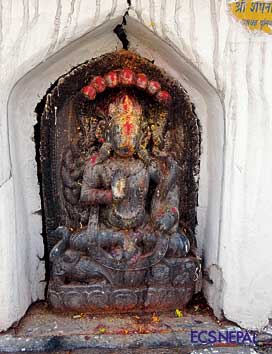Nag Panchami is a festival of the snakes, observed five days after the no-moon day in Shrawan (which is around the end of July, or first week of August). Nags, in Hindu culture, are snake deities, which have a significant space in the history of the religion. On this day, early in the morning, people put up pictures of Nags high on their entrance doors with the help of cow dung, and worship them, along with an offering of milk, dubo (sacred grass), sesame, lava, barley, and nuts. Besides worship in homes, people also go to temples and places known for their importance in relation to Nags, like Nag Pokhari in Kathmandu, Nag Daha in Lalitpur, Changu Narayan in Bhaktapur, and most importantly,Taudaha in Kirtipur. This festival also heralds other festivities coming up in the season.
There are a few legends linked to Nag Panchami, which come from the holy book Mahabharat and other Vedas, and so it varies from place to place, which is why it isn't certain where the tradition originated. The most popular myth is related in the Mahabharat. Lord Shiva, on the day of Shrawan Panchami, defeated the evil serpent Nag Kaliya, and ceased his evil undertaking. Ever since, on this day, Nag Panchamihas been celebrated.
Another mythology dates back to when this valley was once believed to be a lake. People back then saw the prospects of the lake becoming a valley, so they started draining the water out. Nags, who had the supreme power of rain, resided in the lake, and they became furious that their sanctuary was being destroyed. So, they stopped the rains and brought about a severe drought. By means of tantric powers, the people around were able to compel the Nags to put an end to the drought. They also promised to worship them on fifth day of Shrawan to pay homage to their great powers. People also vowed to save a few lakes as safe sanctuary for the snakes to dwell in, so they chose Taudaha in Kirtipurand Nag Daha in Lalitpur. A few still abide by the myth, and think that there are Nags living in those lakes.

There is one more story, which is more locally developed in the Hindu communities of Nepal. We know Nepal is a country heavily dependent on agriculture and farming. This story dates back to the ancient times. A farmer was ploughing his field in the season of harvesting when he mistakenly killed a baby serpent. The mother of this serpent was so furious that she killed all of the farmer’s family members by biting them venomously. Luckily, there was one daughter who worshiped the Nag and put milk and offerings infront of the snake hole to appease its anger. Seeing this devotion, the mother serpent offered a boon to the little girl, and she begged to have her family back. From this point forward, people worship the snake deity to keep their families safe. Some even believe that worshipping Nags on this day will bring their family prosperity, happiness, good health, and security. It is also from this very tale that it is considered a sin to till a land, or plough a field.
In Nepal, Nags are known to be the god of rain, and in most Hindu books, they primarily represent rebirth, death, and mortality. The strongest of the Hindu gods, Shiva,has a snake around his neck. In Nag Panchami, people worship the nine snakes that were known to be the protectors of PatalLok, where Lord Bramha’s son, Kashyap Rishi, along with his thirteen wives, lived. These nine Nags were: Ananta, Vasuki, Shesha, Padmanabha, Kambala, Shankapala, Dhartarashtra, Tashaka, and Kaliya. Kaliya is a popular snake deity, which also has stories linked to Krishna.
This festival is a beautiful incorporation of religion and nature, which shows that people from ages back also respected the creatures of our Earth, and has kept the tradition still intact. From legends and myths, it is also known that this festival has established a harmonious relation with people and animals.










